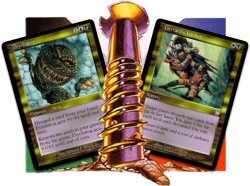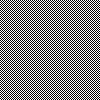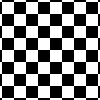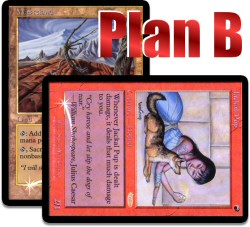Teddy Cardgame, a.k.a. Mail us at https://sales.starcitygames.com/contactus/contactform.php?emailid=2, asked me a couple of questions:
1. Will there ever be another format like this one again? and
2. How do you choose a deck in this format?
[I think I included more curse words in my question, but the gist is right. – Knut]
To the first question, never say never. I think we can all agree that there has never been a format like the current Extended before, but to say that there will never be a format like this one again shows remarkably little foresight. What is distinguishing about this format? Why is it so different from formats that have come before?
The traditional model for the metagame comes all the way from the PTQs from just after Pro Tour I. The deck that won the first Pro Tour was Mike Loconto’s U/W control deck, the finalist was a G/W Armageddon deck, but the most important deck to come out of that tournament was of course Leon Lindback’s mono-Black Necropotence deck. These three decks became the “rock, paper, scissors” model that we have more-or-less accepted since. The thinking was that U/W beat G/W, which beat Necropotence, which beat U/W. Rogue decks came out of that environment, Prison variants based on Winter Orb, Stasis decks at U.S. Nationals, and various Howling Mine decks.
Since that time, conventional wisdom has held that a healthy format includes a small number of tier one decks (say the U/W, G/W, and Necropotence), and that innovation comes from being able to gauge the numbers and react to the relative populations of each deck. The worst formats are those like Mirrodin Block Constructed where there is really only one Tier One deck, and every Tier Two deck is in some ways a reaction to that deck. You can say whatever you want about how good G/R Freshmaker was, but it is hard to imagine a universe where Freshmaker is a viable deck when every other deck isn’t defined by its ability to deal with Arcbound Ravager and Disciple of the Vault.
The reason we think of Mirrodin Block Constructed as a “bad” format is that there is really only one good deck. Sure, you can win a qualifier with one of several U/G decks, G/R, or Tooth and Nail, but it is silly to say that any of these decks is legitimately on par with Vial Affinity. Even other Affinity decks are poor by comparison, and the most hateful decks in the format end up just trading one-for-ones with opponents with more mana and better card drawing.
The current Extended is the flipside, and in its way, a worse format. A lot of people point to the raw number of viable decks and say that this is a “good” thing. It is definitely nice that you can play a variety of different decks, and one of the best aspects about this format is that it is infinitely customizable (just look at the inclusion of Aether Vial in Goblins and Life, the blunt success of Cephalid Breakfast, or how an old control deck or new combo deck creeps up in each week’s Top 8 listings); the bad thing is that a lot of skill comes out.
What do I mean by this?
Before this format, I would say that my favorite Constructed formats were Masques Block Constructed and PTQ Extended 2001, my least favorite format was Championship season Standard 2002. Masques Block Constructed was a small format, similar to Mirrodin Block, but unlike our most recent Block format, it had many viable decks of similar power level. There was beatdown Rebels, chain Rebels, G/W Rebels, black control, Rising Waters, Blue Skies, Aggro Waters, B/G Priest, and G/R. Now this seems like a bad situation in the same sense as the current Extended, but it becomes less so when you are able to isolate the key cards in the various decks. To wit:
Beatdown Rebels: Ramosian Sergeant, Parallax Wave, Reverent Mantra
Chain Rebels: Ramosian Sergeant, Parallax Wave
G/W Rebels: Ramosian Sergeant, Blastoderm, Saproling Burst, Parallax Wave, Reverent Mantra
Black Control: Massacre, Thrashing Wumpus
Rising Waters: Eye of Ramos, Rising Waters, Waterfront Bouncer
Blue Skies: Troublesome Spirit, Gush, Foil, Thwart, Withdraw
Aggro Waters: Rising Waters, Troublesome Spirit, Gush, Foil, Thwart, Waterfront Bouncer
B/G Priest: Blastoderm, Snuff Out
G/R: Blastoderm, Ancient Hydra
You can easily see that the key cards in these decks fall into certain groups, being for the most part, creatures and enchantments. Creating a strategy that is hostile to creatures and enchantments allows you to metagame against many decks at once without diluting the speed or power level of your own deck.
Consider how White might fight in a format like this one.
There are several strong White decks that have access to little or no direct creature kill. A card like Mageta the Lion becomes exceptional in this format. Blinding Angel becomes nearly as good.
Look at the powerhouse Vlack and Blue decks. If you present them with a card like Story Circle, they will have no answer. All you have to do is keep the opponent’s Rising Waters off the table and you can’t lose. You might have a problem finding a way to win, but unless you’re manascrewed, you won’t lose.

Now the reason I hated Standard during the spring and summer of 2002 so much was that you had very little choice about whether or not you were color screwed. Invasion itself was a great Constructed set, but the Invasion Block was hell on deck designers. The most innovative deck designers thrive in formats where they can use one tool to do many jobs at the same time (like in Masques Block Constructed, above), but in a format like Standard 2002, it was too clear which cards were good. How do you compete with a card like Wild Mongrel? You can’t: you’ve just got to play it. But now that you’ve decided to play with Wild Mongrel, how do you get ahead of the other guy, who also has had the foresight to play with possibly the best two-drop in the history of Magic? At some point you just add more colors, because that’s the only way to cram in more power. The multicolored cards were the absolute worst. Psychatog was just a Wild Mongrel that actually dictated what colors you were forced to play. Look, overall, at the power difference between viable card Gerrard’s Verdict and viable card Mind Rot. With power level dictated by colors, players could basically choose between playing under-powered decks with fewer options or being color screwed against opponents with significantly lower skill level. For Regionals that year, I chose to go with the latter:
4 Yavimaya Coast
4 Shivan Reef
3 Karplusan Forest
1 City of Brass
6 Forest
5 Mountain
4 Circular Logic
3 Fact or Fiction
4 Merfolk Looter
4 Arrogant Wurm
4 Birds of Paradise
4 Call of the Herd
4 Wild Mongrel
3 Fiery Temper
4 Flametongue Kavu
3 Violent Eruption
Sideboard
4 Gainsay
1 Persuasion
3 Upheaval
4 Compost
3 Roar of the Wurm
Brian Kibler was the primary designer of this deck, with the sideboard built by myself and John Shuler. I went a whopping 0-2 at that Regionals, playing only against other RUG beatdown decks. I lost to Josh Ravitz in the 75 card mirror in Round One, and got the pain land draw in round two. Of our group, Paul Jordan did reasonably well in the Swiss and Josh made Top 8. That said, I vowed never to play a deck like this one again (which explains, by the way, my dislike for GAT).
There is nothing that a pre-Judgment Deep Dog deck could do that this deck couldn’t do more dramatically. There is nothing that a G/R beatdown deck could do that this deck couldn’t do with more cards in hand. We chose to play this deck, ultimately, because on the numbers, it was the only deck that was legitimately competing with Zevatog in our testing. Despite the fact that Josh ended up doing very well with it, the problem with this deck was that it simply wasn’t a good choice in a tournament where our average opponents weren’t as good as we are.
Let me explain. Look at these two images:


While they look very similar, the picture on the left is a White field with a 50% black gray overlay; the picture on the right is a white field half covered with a checkerboard of 100% black squares. Here are the same pictures at 1200% magnification:


Notice how image 3 is the exact same as image 1, but when you look at the details, image 4 looks a lot different than image 2.
Imagine that every pixel represents a game, and that the first two images represent thousands of games making up a deck’s percentage against a field, with both image 1 and image 2 representing decks with blended 50% matchups against everyone else, played perfectly. The darker the area, the more likely you are to win any particular game (and vice-versa). What I learned at Regionals 2002 was that, the PTQ level at least, it is better to have a deck like image 1, a deck that doesn’t utterly dominate anyone than a deck like image 2, that annihilates half its opponents but can’t win the other half of its games, ever.
This is a giant oversimplification on how decks work, but at the end of the day, you want to have the deck with the darkest overall square, but with the fewest purely white spots. Decks like Kibler’s RUG and GAT, however powerful their best draws, have more empty space than I’d like to see, just because their mana bases don’t hold up, especially against resistance. It’s just impossible.
Think about winning a PTQ with eight rounds of Swiss. If you play a deck with a ton of pain lands – especially a deck with multiple Cities of Brass – you are going to have games where you actually draw them. Now a deck like Life can afford this because it’s a combo deck. But a deck with a midgame is going to have to pay the piper. Your matchup percentages go out the window if one of those games comes up when you are playing RDW and need to win to make Top 8.
This brings us to how I would pick a deck for this format.
Initially, I would take up Josh’s banner and say “don’t play the metagame, just play Magic.” There are simply too many decks to be able to successfully metagame against all of them. Think of a deck like Napster. Napster’s greatest strength was its ability to play Vampiric Tutor and immediately win every known matchup. Unlike a combo deck, Napster didn’t assemble a kill with Vampiric Tutor: what it did was put the opponent into a position where he could not reasonably win in the time allotted. If you are playing Replenish and there is a Stromgald Cabal in play, how likely do you think it is that you assemble the eight mana required for Parallax Wave and Replenish before the opponent’ Phyrexian Negator eats you? How likely do you think it is for Trinity Green to hit the mana necessary for Plow Under with Engineered Plague in play? Will this happen before or after Thrashing Wumpus kills everybody, including you?
Now you can’t really play Perish and Rapid Decay and Stromgald Cabal and every other hate card we ran in 2000 in today’s Extended. Unless you are some kind of design genius, you can’t accurately game against Mind’s Desire and Aluren and Cephalid Brunch and West and Hybrid West and Topdeck West and Psychatog and all the Red Decks and especially The Rock all in one deck. You just don’t have room for all the hate and sufficient speed to win. Unless you are some kind of genius with a new deck, that is.

That is why we picked Red Deck Wins for the Grand Prix. When you can’t predict all your matchups… you burn. Jackal Pup + Wasteland doesn’t care what the opponent’s deck is. That was the theory, anyway. Of course we ran into The Limit of Interactivity, but that was another story.
Right now, I would say that my decision matrix is a little different. I still fundamentally like Red Deck Wins the best, but at this point, I don’t know if I can personally win a PTQ with it. Top 8? Definitely. But the problem is that almost every PTQ Top 8 features a U/W Mind’s Desire deck, and in order to actually win the PTQ, I’d have to beat that guy. This week, Dan told me I have The Fear. Frown.
Recently, I posted a B/G Quirion Dryad deck. I said that its bad matchups were Red Decks. I fixed those matchups but actually forgot about The Rock. Back when I played Black Thumb two years ago, The Rock was our worst matchup. It was like playing the mirror… except they had all the two-for-ones. Sure their two-for-ones were garbage, but they still had them. Not surprisingly, I bit it to The Rock, played pretty well, this past weekend. Who forgets to prep for the most popular deck at the relevant Pro Tour?
Among the known archetypes, the decks I am most gravitating to today are Psychatog and Trinity Green. I don’t like either of these decks the way that I like Red Deck Wins, but I quite like their combination of mana consistency and power. Psychatog can’t really deal with a permanent very well, but it is a great true control deck with a great creature and a potential combo kill. Trinity Green carries with it the spirit of Red Deck Wins. It plays some guys and then can cast turn three Plow Under… no matter the matchup.
In sum, here are some general rules I play by when choosing decks:
1. The greater the disparity in skill level between you and your projected opponent, the more (or less) consistent you should make your mana base. Remember my mono-Blue deck from States/Columbus LCQ? I played a significantly more conservative mana base than did [author name="Star Wars Kid"]Star Wars Kid[/author]. The reason is that my baseline belief after the Kibler RUG fiasco three years ago is that I need to run my mana first, and everything else will fall into place after.
2. The corollary to this is that the more I am out-classed, the more likely I am to play a deck like figure 2, above. If I were playing in a Constructed Pro Tour (except maybe the upcoming Philadelphia, with the new prize structure), I’d play the “darkest square” that I could, overall, even if it had blinding bursts of empty white. The reason is that the “blank” areas are are much more likely to coincide with games that I would lose anyway. Like, I don’t know how much it matters that I am manascrewed in a particular game if my opponent is Masashi Oiso. I’d trade those blanks for a better shot to win more games, rather than try to match my medium grays against my betters.
Almost any real deck can win a PTQ right now. Even some not real decks can win PTQs. Teen Titans is not the only Type I deck that is cropping up in Extended, and there are twenty more viable decks when you get done getting locked by Greg Weiss’s newest weapon. Because of that, I think that it is more important than ever to choose a deck that won’t betray you via mana in a matchup where you know you can win, against an opponent, against a deck, that you’ve prepared to beat. The best advice I’ve gotten in the past couple of weeks was from Brian David-Marshall:
“I really want you to win; add a land.”
LOVE
MIKE
